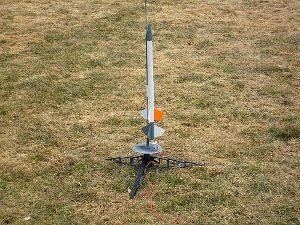| Construction Rating: | starstarstarstarstar_border |
| Flight Rating: | starstarstarstarstar |
| Overall Rating: | starstarstarstarstar |
| Diameter: | 0.98 inches |
| Length: | 20.25 inches |
| Manufacturer: | Quest  |
| Skill Level: | 3 |
| Style: | Multi-Stage, Scale |

Brief:
Quest Navaho AGM is a 2-stage rocket with a 14" parachute. It's rated as a level III model kit. This is my first
Quest rocket I've built. I decided to try a different 2-stage rocket kit.
Construction:
I was very impressed with the quality of the parts.
The parts list:
- 1 14" White Body Tube
- 1 3" White Body Tube
- 2 Motor Clips
- 2 Blue Thrust Rings
- 2 Yellow Motor Mount Tubes
- 4 Red Centering Rings
- 1 Water Slide Decal Sheet
- 1 Plastic Nose Cone
- 1 Tube Coupler
- 1 Launch Lug
- 1 24" White Elastic Shock Cord
- 1 Instruction Sheet
- 1 Launch Procedures Sheet
- 1 21" Yellow Kevlar® Shock Cord
- 3 26" Shroud Lines
- 6 Tyvek Labels
- 1 14" Parachute
- 1 Laser Cut Balsa Fin Set

The instructions are easy to follow and well illustrated. The construction of this rocket was easy for being rated a level III build. I do like the heavy motor mount tubes. Make sure you follow the fin aliment to the letter or it will cause stability problems. A friend of mine learned that the hard way. I used white glue and wood glue to assemble this rocket.
Finishing:
First thing I did was add two coats of sanding sealer to the fins, sanded with 320 grit sandpaper, added a third
coat, and sanded again. I also did the forward stakes too.
I primed the whole model with white primer and used 320 grit sandpaper to make it smooth. I used gloss gray spray paint on the NC and lower booster. You will want tape off one fin and spray paint that fin with gloss white. The upper section with one fin tape off was sprayed with white gloss paint. The covered fin was later sprayed with gloss orange.
The decals went on easily and they are rather thick. I still need to finish adding the rest of the decals.
Construction Rating: 4 out of 5
Flight:
My first flight was using Estes A8-0/A8-3. The second stage didn't light and crashed, but there was no damage. The
second flight was Estes B6-0/A8-3. Great flight really took off towards the sky.
Recovery:
Parachute opened beautifully, I didn't think I was going get it back as the wind kicked up and the rocket drifted
into a neighbors backyard. I recovered it with no damage. I will find a bigger flying area for this rocket next time.
Flight Rating: 5 out of 5
Summary:
Nice 2 stage rocket to fly. Make sure you have a large flying field for this rocket land and launch in little or no
wind.
Overall Rating: 5 out of 5
Other Reviews
- Quest Navaho AGM By Jim Bassham (February 24, 2009)
Brief: Two-stage scale rocket. Construction: Paper tubes, die-cut balsa fins, plastic nose cone, Kevlar ® /elastic shock cord. Motor retaining clips. This was a really straightforward kit that went together easily. The instructions were well written and clear. The assembly went smoothly. This kit is designed like other Quest kits with their Kevlar ® shock cord ...
- Quest Navaho AGM By Tai Fu (January 3, 2008)
Navaho is a 2 staged rocket made by Quest. I bought this in Hobby Lobby because I thought I'd give a 2- stage another chance (the first one failed me by coming down in flames after stage separated). The rocket comes in a clear plastic bag just like most Estes rockets. No broken parts. I kinda liked the tab mounting of parachutes because it's easier to put on, however, it's not as strong as ...
 |
 |
Flights
 |
 |
T.E.B. (October 26, 2001)
N.A.S. (November 9, 2001)
C.C.C. (December 7, 2001)
R.B. (February 11, 2005)
M.A. (September 27, 2009)
 |
 |
D.K. (November 1, 1999)